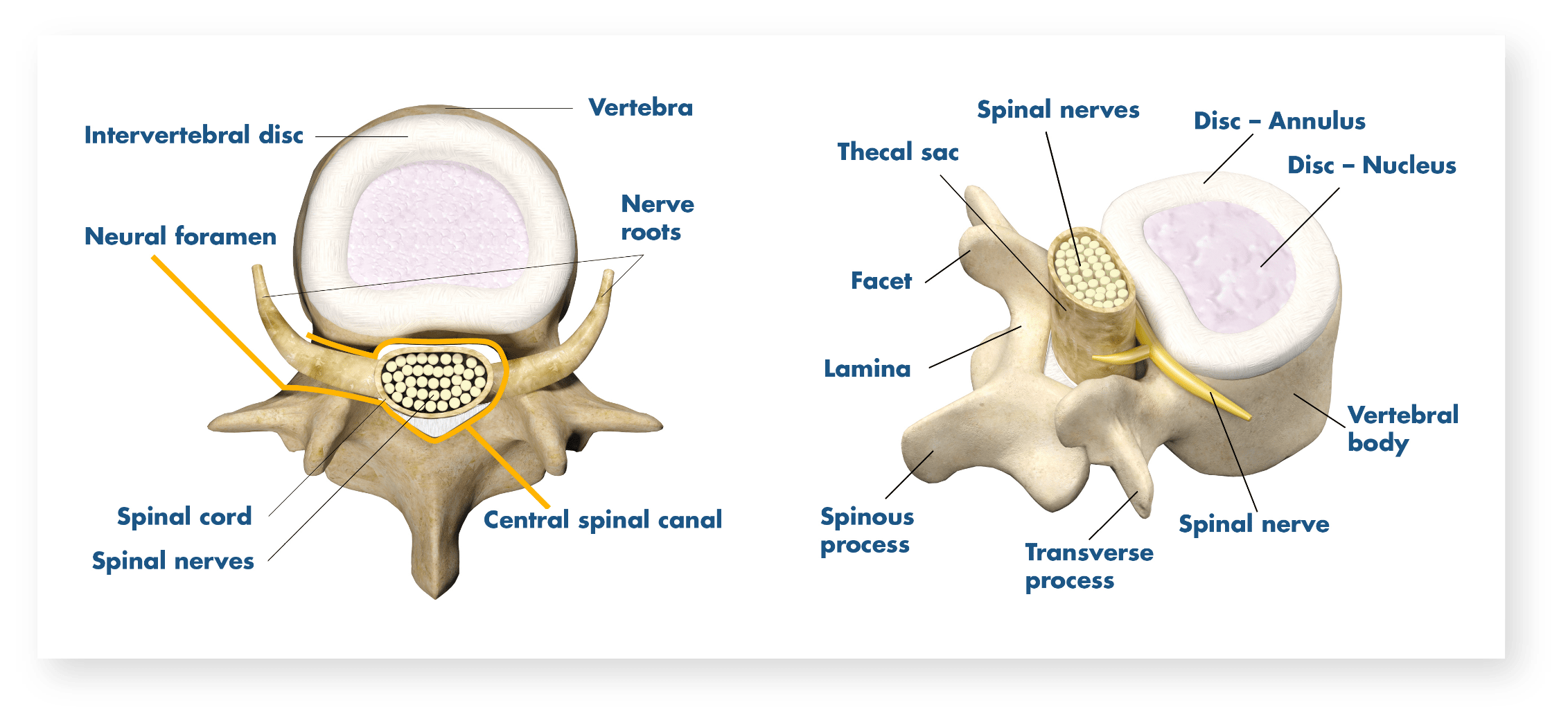How does the back work?
To get a better idea of why your back hurts, take a look at how it works. The spine is made up of 33 bones, called vertebrae or vertebral bodies. The vertebrae are positioned one on top of another from the base of the skull to the pelvis.
A shock absorbing structure called an intervertebral disc sits between each vertebra, and each spinal segment (defined as two vertebrae separated by one intervertebral disc) is connected by two small articulating surfaces called facet joints.
Together, the vertebrae and intervertebral discs form the spinal column. The spinal column supports the weight of the head and upper body, serves as an attachment point for muscles and ligaments that allow you to perform every day activities, and most importantly, protects the spinal cord.
Seventeen vertebrae make up the mid to lower back (or thoracolumbar) region of the spine. When the bones or discs in the back become diseased or injured, it can affect one’s ability to move and work.

It's time to take your back pain off the back burner

What does your pain feel like? If it occurs suddenly and feels severe, but only lasts for a short period of time, it may be what doctors refer to as acute pain. In contrast, if your pain is persistent and hasn’t improved over time, it may be chronic pain.
Doctors will try to understand what type of pain you’re experiencing. You may be experiencing mechanical pain because of a breakdown or inflammation in the mechanical components of the spine that create movement – the discs, facet joints, ligaments or muscles. Or, you may be experiencing neurological pain because the spinal canal has been narrowed or compromised, causing irritation of the spinal cord or spinal nerves, which in turn can cause pain in the back, or numbness or weakness in the legs.
If any of the following symptoms persist, it’s important that you consult with your doctor:
Degenerative disc disease is the progressive deterioration of the intervertebral discs throughout the spine that can occur as we age.
A herniated disc occurs when a small portion of an intervertebral disc shifts to an abnormal location, putting pressure on the spinal nerves.
Lumbar spinal stenosis is a narrowing of the spaces through which the spinal nerves pass.
Spondylolisthesis is defined as a slippage of one spinal bone (vertebra) relative to an adjacent vertebra.
Scoliosis is defined as a sideways curvature of the spine that measures greater than 10 degrees.
Vertebral body fractures are injuries to the spinal bones that can be caused by osteoporosis, spinal tumors, or trauma and can result in either the gradual or sudden onset of back pain and/or neurological symptoms.
Find out why your back hurts.
What will a doctor do?
The first time your doctor meets you, he/she will try to assess what’s going on. You’ll answer a few questions about your symptoms. He/she will ask you to replicate the movements that may be causing you pain or discomfort. The doctor may understand what’s going on right away because you show classic symptoms of a particular problem. Or, the doctor may ask you to have an additional diagnostic test, like an X-ray or an MRI.
It’s important to keep in mind that symptom relief doesn't always mean surgery. Your doctor may recommend a combination of treatments to help alleviate your symptoms. Learn more about your options here.
IMPORTANT INFORMATION ABOUT SPINE SURGERY
Some of the images on this website depict Stryker’s products. Please speak to your doctor if you have questions about these products or anything else in this website.
The information presented is for educational purposes only. Stryker is not dispensing medical advice. Please speak to your doctor to decide if spinal surgery is right for you. Only your doctor can make the medical judgment regarding which products and treatments are right for your own individual condition.
As with any surgery, spinal surgery carries certain risks. Your surgeon will explain all the possible complications of the surgery, as well as side effects. Each spinal surgery patient will experience a different post-operative activity level, depending on his/her own individual clinical factors. Your doctor will help counsel about how to best maintain your activities in order to recover properly from your surgery. Such activities include not engaging in high-impact activities that could de-stabilize any instrumentation that may have been implanted.
Stryker Corporation or its divisions or other corporate affiliated entities own, use or have applied for the following trademarks or service marks: Stryker. All other trademarks are trademarks of their respective owners or holders.
Ask your doctor if spine surgery is right for you.
GEN-WB-24-32016